A Comprehensive Analysis of Backup and Disaster Recovery Plan Issues
VerifiedAdded on 2023/06/15
|6
|1184
|404
Report
AI Summary
This report analyzes the problems associated with backup and disaster recovery plans, highlighting issues such as inadequate planning, failure to gain senior management support, insufficient storage capacity, and lack of backup testing. It addresses the importance of updating disaster recovery plans and rectifying identified problems. The study emphasizes that many businesses have backup plans but lack comprehensive disaster recovery strategies. The emergence of cloud technologies as a solution is discussed, noting that cloud-based solutions offer a way to improve enterprise disaster recovery by leveraging log files for database updates. The report concludes that well-planned disaster recovery solutions are critical for organizations operating 24/7, minimizing disruption during unplanned outages. It also explores how technological advancements contribute to business continuity and support customer objectives.
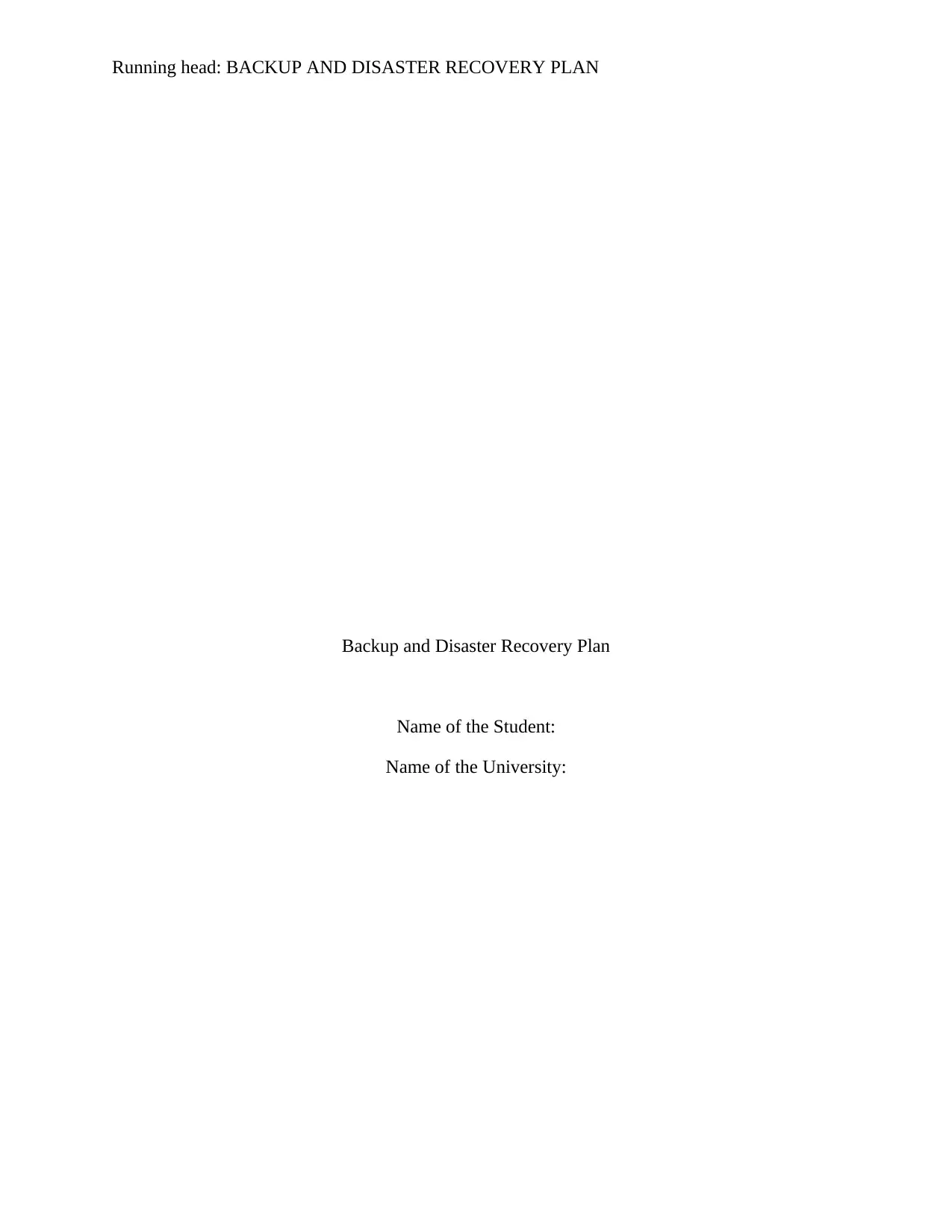
Running head: BACKUP AND DISASTER RECOVERY PLAN
Backup and Disaster Recovery Plan
Name of the Student:
Name of the University:
Backup and Disaster Recovery Plan
Name of the Student:
Name of the University:
Paraphrase This Document
Need a fresh take? Get an instant paraphrase of this document with our AI Paraphraser
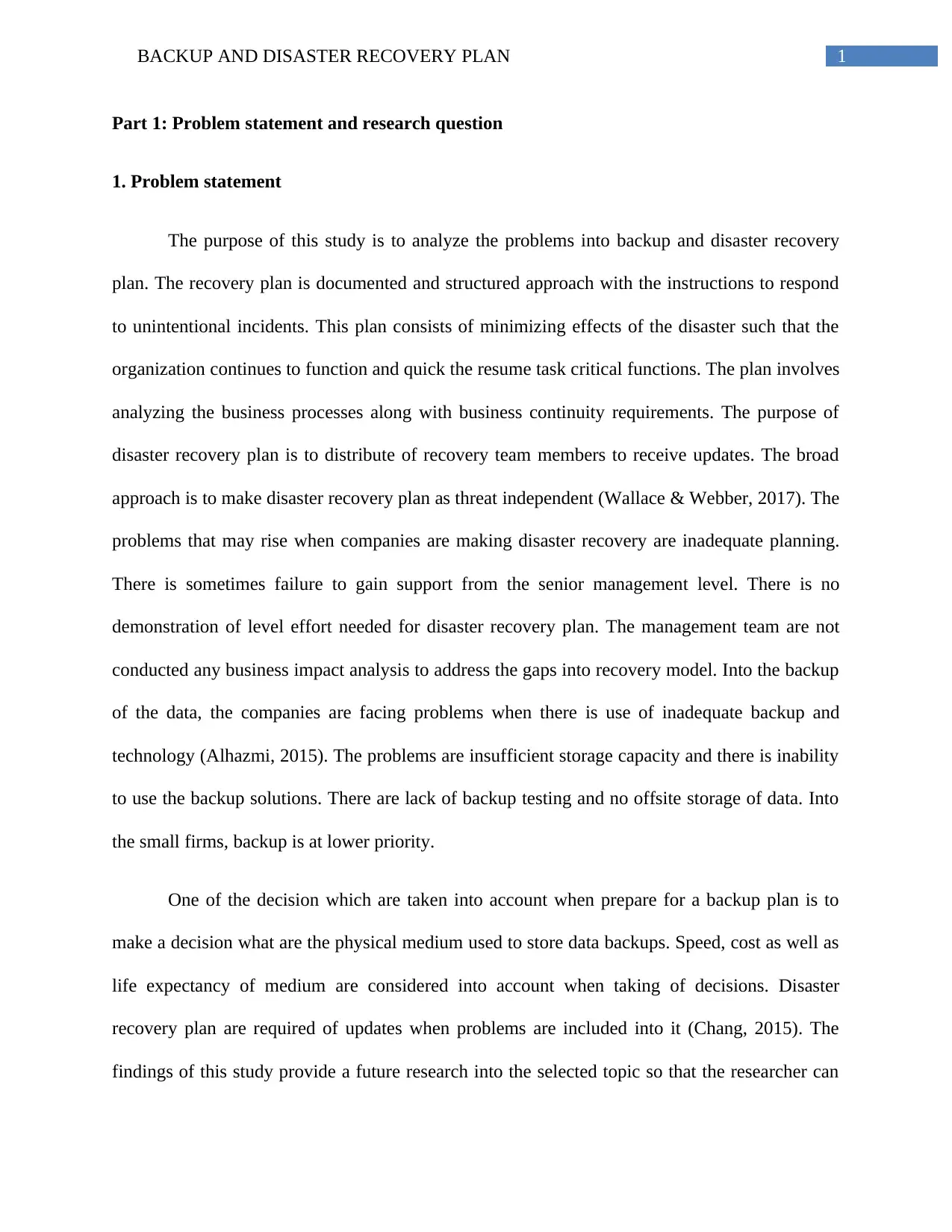
1BACKUP AND DISASTER RECOVERY PLAN
Part 1: Problem statement and research question
1. Problem statement
The purpose of this study is to analyze the problems into backup and disaster recovery
plan. The recovery plan is documented and structured approach with the instructions to respond
to unintentional incidents. This plan consists of minimizing effects of the disaster such that the
organization continues to function and quick the resume task critical functions. The plan involves
analyzing the business processes along with business continuity requirements. The purpose of
disaster recovery plan is to distribute of recovery team members to receive updates. The broad
approach is to make disaster recovery plan as threat independent (Wallace & Webber, 2017). The
problems that may rise when companies are making disaster recovery are inadequate planning.
There is sometimes failure to gain support from the senior management level. There is no
demonstration of level effort needed for disaster recovery plan. The management team are not
conducted any business impact analysis to address the gaps into recovery model. Into the backup
of the data, the companies are facing problems when there is use of inadequate backup and
technology (Alhazmi, 2015). The problems are insufficient storage capacity and there is inability
to use the backup solutions. There are lack of backup testing and no offsite storage of data. Into
the small firms, backup is at lower priority.
One of the decision which are taken into account when prepare for a backup plan is to
make a decision what are the physical medium used to store data backups. Speed, cost as well as
life expectancy of medium are considered into account when taking of decisions. Disaster
recovery plan are required of updates when problems are included into it (Chang, 2015). The
findings of this study provide a future research into the selected topic so that the researcher can
Part 1: Problem statement and research question
1. Problem statement
The purpose of this study is to analyze the problems into backup and disaster recovery
plan. The recovery plan is documented and structured approach with the instructions to respond
to unintentional incidents. This plan consists of minimizing effects of the disaster such that the
organization continues to function and quick the resume task critical functions. The plan involves
analyzing the business processes along with business continuity requirements. The purpose of
disaster recovery plan is to distribute of recovery team members to receive updates. The broad
approach is to make disaster recovery plan as threat independent (Wallace & Webber, 2017). The
problems that may rise when companies are making disaster recovery are inadequate planning.
There is sometimes failure to gain support from the senior management level. There is no
demonstration of level effort needed for disaster recovery plan. The management team are not
conducted any business impact analysis to address the gaps into recovery model. Into the backup
of the data, the companies are facing problems when there is use of inadequate backup and
technology (Alhazmi, 2015). The problems are insufficient storage capacity and there is inability
to use the backup solutions. There are lack of backup testing and no offsite storage of data. Into
the small firms, backup is at lower priority.
One of the decision which are taken into account when prepare for a backup plan is to
make a decision what are the physical medium used to store data backups. Speed, cost as well as
life expectancy of medium are considered into account when taking of decisions. Disaster
recovery plan are required of updates when problems are included into it (Chang, 2015). The
findings of this study provide a future research into the selected topic so that the researcher can
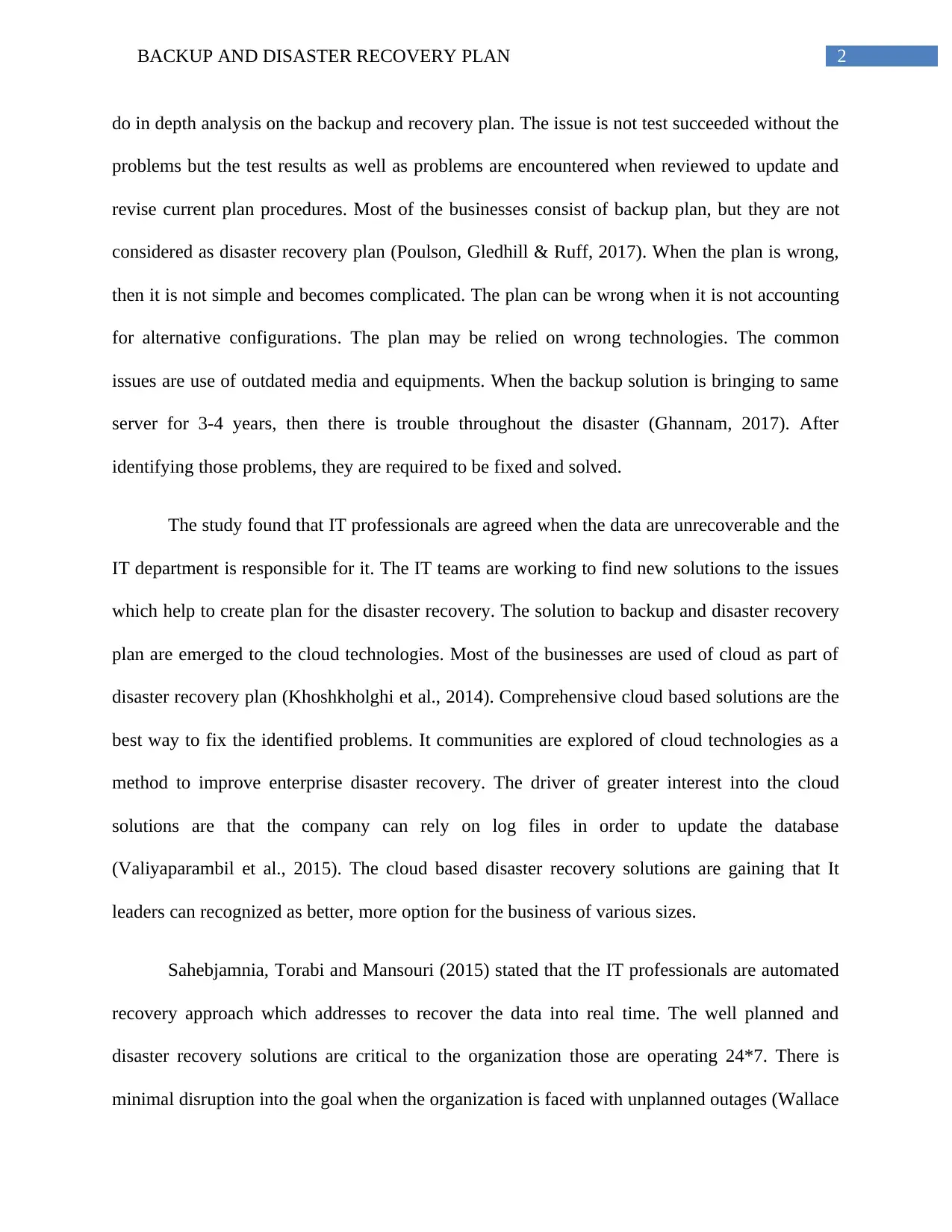
2BACKUP AND DISASTER RECOVERY PLAN
do in depth analysis on the backup and recovery plan. The issue is not test succeeded without the
problems but the test results as well as problems are encountered when reviewed to update and
revise current plan procedures. Most of the businesses consist of backup plan, but they are not
considered as disaster recovery plan (Poulson, Gledhill & Ruff, 2017). When the plan is wrong,
then it is not simple and becomes complicated. The plan can be wrong when it is not accounting
for alternative configurations. The plan may be relied on wrong technologies. The common
issues are use of outdated media and equipments. When the backup solution is bringing to same
server for 3-4 years, then there is trouble throughout the disaster (Ghannam, 2017). After
identifying those problems, they are required to be fixed and solved.
The study found that IT professionals are agreed when the data are unrecoverable and the
IT department is responsible for it. The IT teams are working to find new solutions to the issues
which help to create plan for the disaster recovery. The solution to backup and disaster recovery
plan are emerged to the cloud technologies. Most of the businesses are used of cloud as part of
disaster recovery plan (Khoshkholghi et al., 2014). Comprehensive cloud based solutions are the
best way to fix the identified problems. It communities are explored of cloud technologies as a
method to improve enterprise disaster recovery. The driver of greater interest into the cloud
solutions are that the company can rely on log files in order to update the database
(Valiyaparambil et al., 2015). The cloud based disaster recovery solutions are gaining that It
leaders can recognized as better, more option for the business of various sizes.
Sahebjamnia, Torabi and Mansouri (2015) stated that the IT professionals are automated
recovery approach which addresses to recover the data into real time. The well planned and
disaster recovery solutions are critical to the organization those are operating 24*7. There is
minimal disruption into the goal when the organization is faced with unplanned outages (Wallace
do in depth analysis on the backup and recovery plan. The issue is not test succeeded without the
problems but the test results as well as problems are encountered when reviewed to update and
revise current plan procedures. Most of the businesses consist of backup plan, but they are not
considered as disaster recovery plan (Poulson, Gledhill & Ruff, 2017). When the plan is wrong,
then it is not simple and becomes complicated. The plan can be wrong when it is not accounting
for alternative configurations. The plan may be relied on wrong technologies. The common
issues are use of outdated media and equipments. When the backup solution is bringing to same
server for 3-4 years, then there is trouble throughout the disaster (Ghannam, 2017). After
identifying those problems, they are required to be fixed and solved.
The study found that IT professionals are agreed when the data are unrecoverable and the
IT department is responsible for it. The IT teams are working to find new solutions to the issues
which help to create plan for the disaster recovery. The solution to backup and disaster recovery
plan are emerged to the cloud technologies. Most of the businesses are used of cloud as part of
disaster recovery plan (Khoshkholghi et al., 2014). Comprehensive cloud based solutions are the
best way to fix the identified problems. It communities are explored of cloud technologies as a
method to improve enterprise disaster recovery. The driver of greater interest into the cloud
solutions are that the company can rely on log files in order to update the database
(Valiyaparambil et al., 2015). The cloud based disaster recovery solutions are gaining that It
leaders can recognized as better, more option for the business of various sizes.
Sahebjamnia, Torabi and Mansouri (2015) stated that the IT professionals are automated
recovery approach which addresses to recover the data into real time. The well planned and
disaster recovery solutions are critical to the organization those are operating 24*7. There is
minimal disruption into the goal when the organization is faced with unplanned outages (Wallace
⊘ This is a preview!⊘
Do you want full access?
Subscribe today to unlock all pages.

Trusted by 1+ million students worldwide
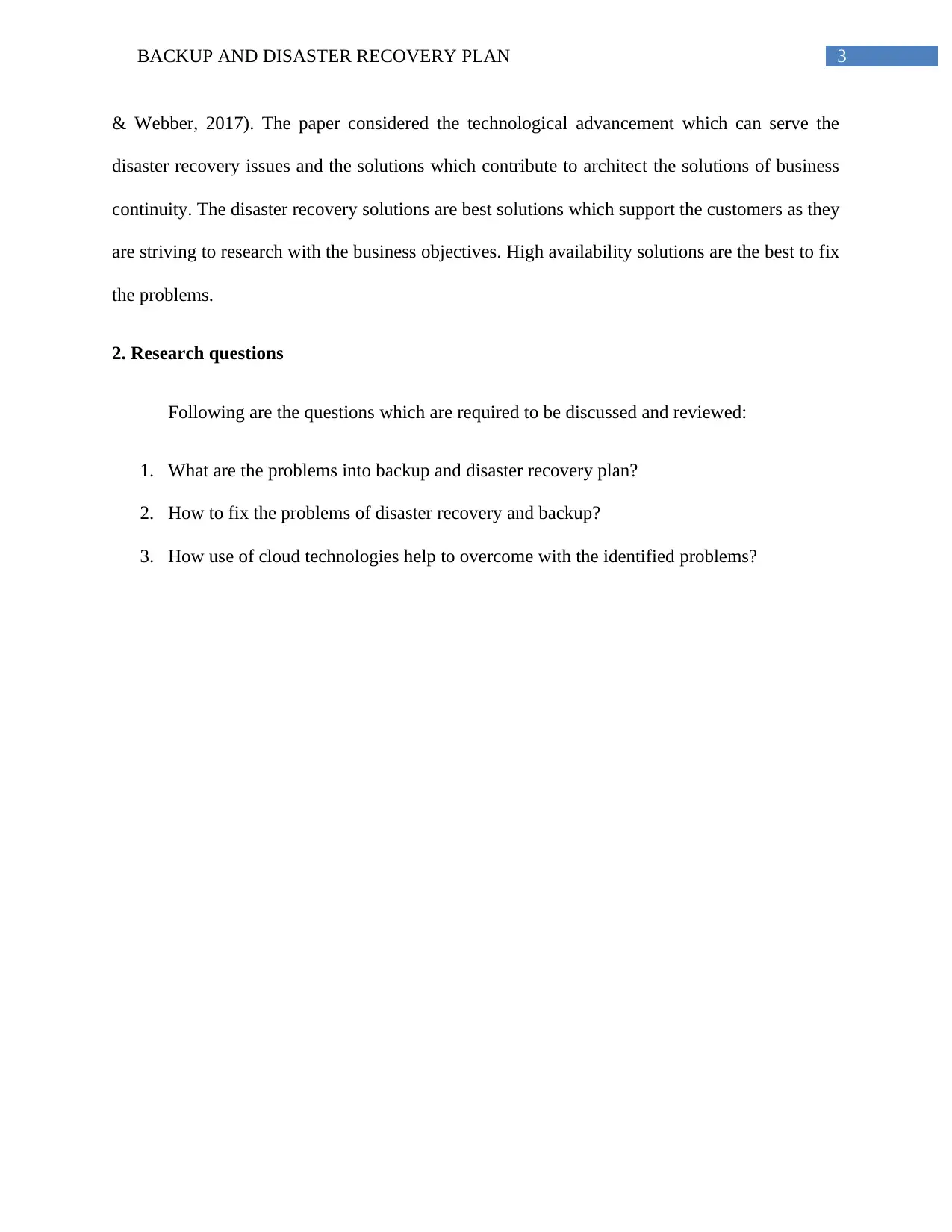
3BACKUP AND DISASTER RECOVERY PLAN
& Webber, 2017). The paper considered the technological advancement which can serve the
disaster recovery issues and the solutions which contribute to architect the solutions of business
continuity. The disaster recovery solutions are best solutions which support the customers as they
are striving to research with the business objectives. High availability solutions are the best to fix
the problems.
2. Research questions
Following are the questions which are required to be discussed and reviewed:
1. What are the problems into backup and disaster recovery plan?
2. How to fix the problems of disaster recovery and backup?
3. How use of cloud technologies help to overcome with the identified problems?
& Webber, 2017). The paper considered the technological advancement which can serve the
disaster recovery issues and the solutions which contribute to architect the solutions of business
continuity. The disaster recovery solutions are best solutions which support the customers as they
are striving to research with the business objectives. High availability solutions are the best to fix
the problems.
2. Research questions
Following are the questions which are required to be discussed and reviewed:
1. What are the problems into backup and disaster recovery plan?
2. How to fix the problems of disaster recovery and backup?
3. How use of cloud technologies help to overcome with the identified problems?
Paraphrase This Document
Need a fresh take? Get an instant paraphrase of this document with our AI Paraphraser
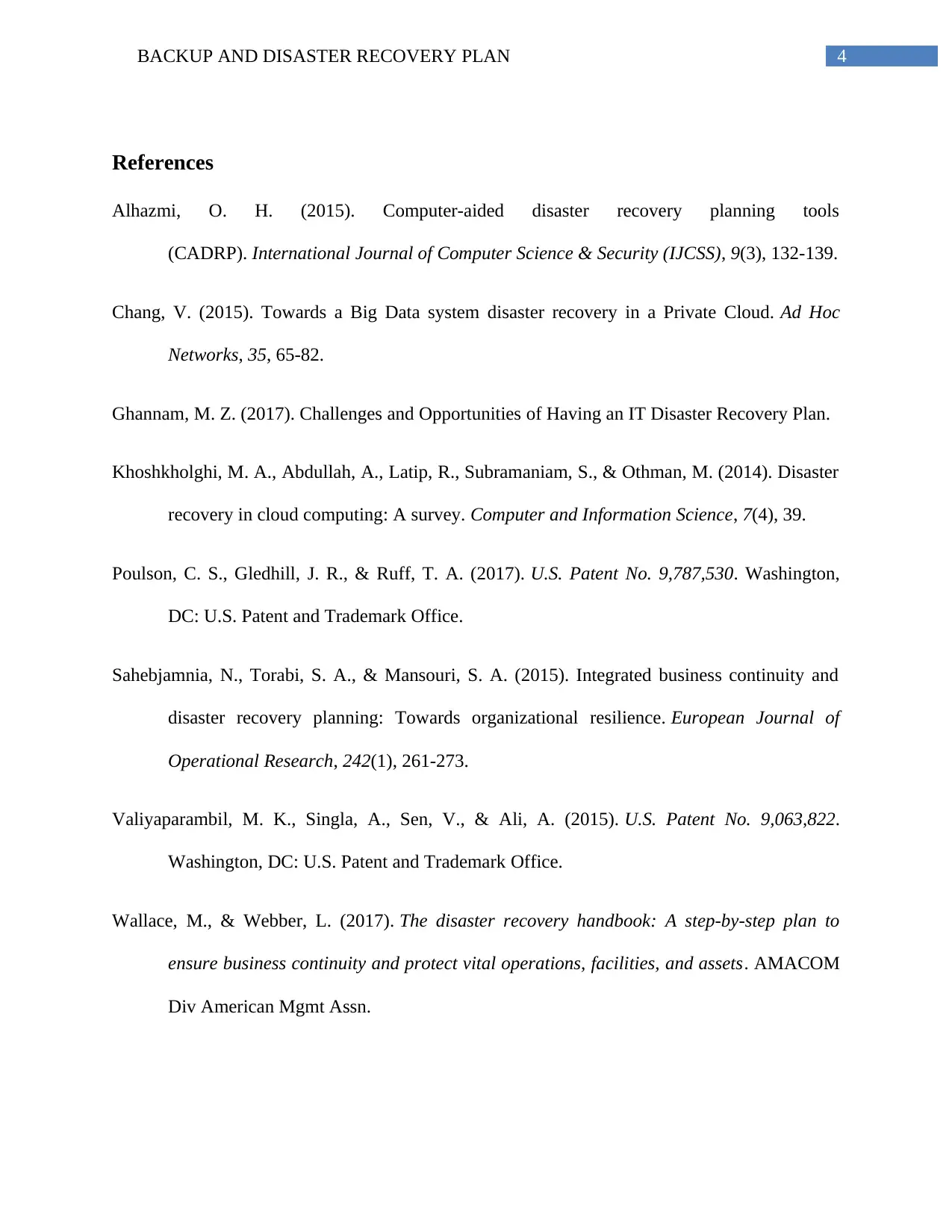
4BACKUP AND DISASTER RECOVERY PLAN
References
Alhazmi, O. H. (2015). Computer-aided disaster recovery planning tools
(CADRP). International Journal of Computer Science & Security (IJCSS), 9(3), 132-139.
Chang, V. (2015). Towards a Big Data system disaster recovery in a Private Cloud. Ad Hoc
Networks, 35, 65-82.
Ghannam, M. Z. (2017). Challenges and Opportunities of Having an IT Disaster Recovery Plan.
Khoshkholghi, M. A., Abdullah, A., Latip, R., Subramaniam, S., & Othman, M. (2014). Disaster
recovery in cloud computing: A survey. Computer and Information Science, 7(4), 39.
Poulson, C. S., Gledhill, J. R., & Ruff, T. A. (2017). U.S. Patent No. 9,787,530. Washington,
DC: U.S. Patent and Trademark Office.
Sahebjamnia, N., Torabi, S. A., & Mansouri, S. A. (2015). Integrated business continuity and
disaster recovery planning: Towards organizational resilience. European Journal of
Operational Research, 242(1), 261-273.
Valiyaparambil, M. K., Singla, A., Sen, V., & Ali, A. (2015). U.S. Patent No. 9,063,822.
Washington, DC: U.S. Patent and Trademark Office.
Wallace, M., & Webber, L. (2017). The disaster recovery handbook: A step-by-step plan to
ensure business continuity and protect vital operations, facilities, and assets. AMACOM
Div American Mgmt Assn.
References
Alhazmi, O. H. (2015). Computer-aided disaster recovery planning tools
(CADRP). International Journal of Computer Science & Security (IJCSS), 9(3), 132-139.
Chang, V. (2015). Towards a Big Data system disaster recovery in a Private Cloud. Ad Hoc
Networks, 35, 65-82.
Ghannam, M. Z. (2017). Challenges and Opportunities of Having an IT Disaster Recovery Plan.
Khoshkholghi, M. A., Abdullah, A., Latip, R., Subramaniam, S., & Othman, M. (2014). Disaster
recovery in cloud computing: A survey. Computer and Information Science, 7(4), 39.
Poulson, C. S., Gledhill, J. R., & Ruff, T. A. (2017). U.S. Patent No. 9,787,530. Washington,
DC: U.S. Patent and Trademark Office.
Sahebjamnia, N., Torabi, S. A., & Mansouri, S. A. (2015). Integrated business continuity and
disaster recovery planning: Towards organizational resilience. European Journal of
Operational Research, 242(1), 261-273.
Valiyaparambil, M. K., Singla, A., Sen, V., & Ali, A. (2015). U.S. Patent No. 9,063,822.
Washington, DC: U.S. Patent and Trademark Office.
Wallace, M., & Webber, L. (2017). The disaster recovery handbook: A step-by-step plan to
ensure business continuity and protect vital operations, facilities, and assets. AMACOM
Div American Mgmt Assn.

5BACKUP AND DISASTER RECOVERY PLAN
⊘ This is a preview!⊘
Do you want full access?
Subscribe today to unlock all pages.

Trusted by 1+ million students worldwide
1 out of 6
Related Documents
Your All-in-One AI-Powered Toolkit for Academic Success.
+13062052269
info@desklib.com
Available 24*7 on WhatsApp / Email
![[object Object]](/_next/static/media/star-bottom.7253800d.svg)
Unlock your academic potential
Copyright © 2020–2025 A2Z Services. All Rights Reserved. Developed and managed by ZUCOL.



